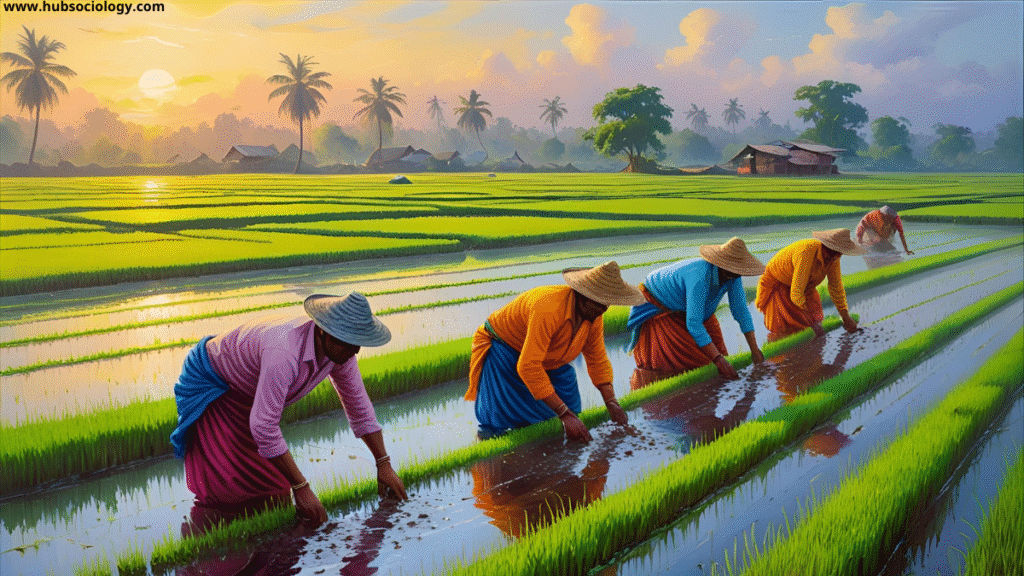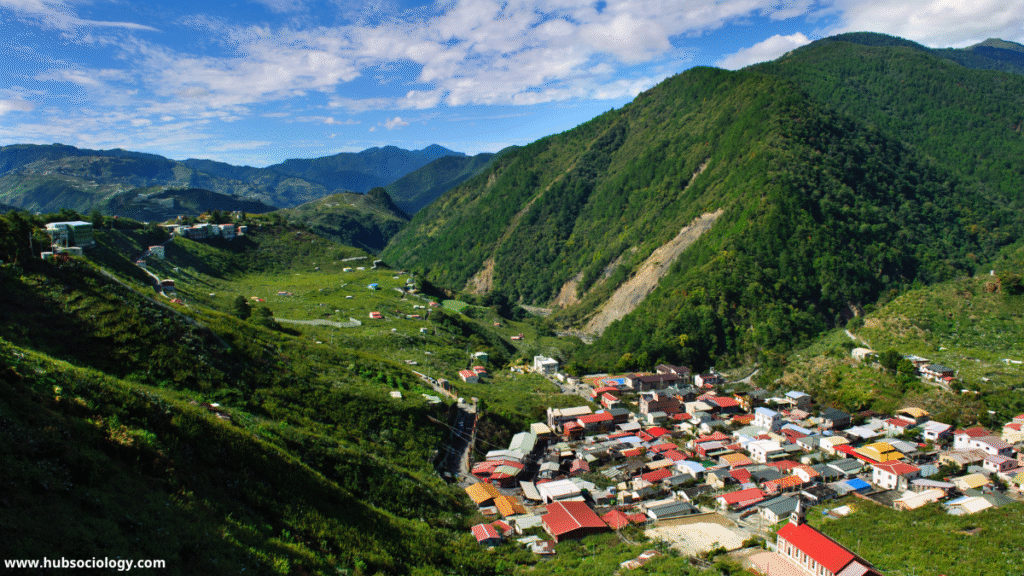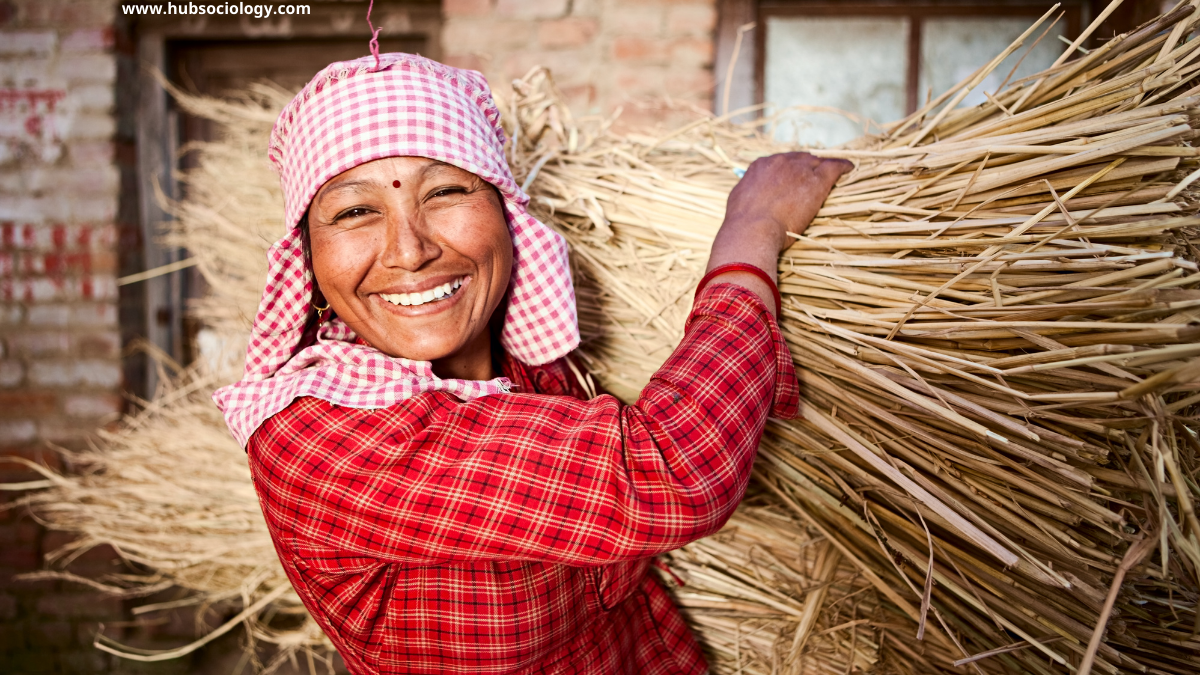Introduction
India is often described as a land of villages. Despite rapid urbanization and the growth of metropolitan cities, the rural population continues to represent the heart of the nation’s demographic and social structure. Villages in India are not merely administrative units—they are living communities where traditional norms, social relations, and local institutions have evolved over centuries. The population and its distribution across villages form the foundation of rural sociology, as they directly influence the social organization, economy, culture, and development patterns of the nation.
Understanding the village population and its distribution in India thus requires a sociological lens that integrates demographic data with social dynamics.

Meaning of Village Population
The term village population refers to the segment of people living in rural settlements as defined by the Census of India. According to the Census, an area is considered rural (or a village) if it has:
- A population of less than 5,000;
- A density of population less than 400 persons per square kilometer; and
- At least 75% of the male working population engaged in agriculture or allied activities.
This definition highlights that rural population is not only defined by numbers or size but also by its occupational and social structure. The village population thus comprises individuals who are closely tied to land, agriculture, and community life, with kinship, caste, and religion playing central roles in shaping social relations.
Size and Growth of Village Population in India
According to the Census of India 2011, about 68.84% of India’s total population lived in villages, amounting to over 833 million people. Although the percentage of rural population has declined over time (from 82.7% in 1951), the absolute number has steadily increased. This reflects the demographic pressure on rural India, where population growth has outpaced the development of resources and employment opportunities.
The post-independence period witnessed a slow but consistent migration from villages to cities due to industrialization, education, and urban employment opportunities. However, even with this migration, the rural population continues to grow because of high fertility rates, limited family planning awareness, and improvements in healthcare that have reduced mortality.
Spatial Distribution of Village Population
The distribution of the village population in India is highly uneven due to geographical, economic, and cultural factors. Broadly, the rural population is denser in fertile and agriculturally productive regions, while sparse in arid, hilly, or forested regions.
- Northern Plains:
States such as Uttar Pradesh, Bihar, West Bengal, and Punjab have a high density of village population. The alluvial soil and availability of water resources have supported intensive agriculture and large rural settlements. - Peninsular Plateau:
States like Madhya Pradesh, Maharashtra, Karnataka, and Andhra Pradesh have a moderate distribution of villages. Here, the village size varies due to topography and irrigation patterns. - Coastal Regions:
The coastal belts of Kerala, Tamil Nadu, and Odisha have compact village settlements with mixed occupations—farming, fishing, and trade. - Desert and Hilly Areas:
Villages in Rajasthan, Himachal Pradesh, Uttarakhand, and the North-Eastern states are scattered and smaller in size due to difficult terrain, poor soil fertility, and limited accessibility.
This uneven distribution reflects the sociological reality that geography shapes human settlement, occupation, and community organization.
Sociological Characteristics of Village Population
From a sociological viewpoint, the village population in India exhibits unique social characteristics that distinguish it from urban society. These include:
- Caste and Social Hierarchy:
The caste system remains a defining feature of village social structure. Land ownership, occupation, and social prestige are often linked to caste identity. While modernization and legal reforms have challenged caste barriers, caste networks still influence marriage, politics, and social mobility. - Kinship and Family:
The rural population lives largely in joint or extended family systems, where kinship ties provide economic and emotional support. Family and kin relations play crucial roles in maintaining social cohesion. - Agrarian Economy:
Agriculture is the dominant occupation, directly employing a large share of the rural workforce. The relationship between landowners and landless laborers continues to define class relations in villages. - Community Solidarity:
Villages exhibit strong social bonds based on traditions, festivals, and collective decision-making through institutions like the panchayat. This communal life fosters cooperation but can also resist change. - Religious and Cultural Life:
Religion shapes daily life, moral values, and festivals in rural areas. Local deities, temples, and rituals contribute to the cultural identity of each village. - Slow Social Mobility:
Due to traditional norms, limited education, and lack of industrial employment, the rural population often experiences restricted upward mobility compared to urban counterparts.
Factors Affecting Village Population Distribution
Several interrelated factors influence how the village population is distributed across India:

- Physical Factors:
Topography, climate, and soil fertility determine where people can live and farm. Fertile plains have dense populations, while arid or forested areas remain sparsely populated. - Economic Opportunities:
Regions with better irrigation, infrastructure, and market access attract more people. Agricultural productivity often determines settlement density. - Historical Factors:
Ancient civilizations and kingdoms in river valleys like the Ganges or Godavari led to the early concentration of population in these regions. - Cultural and Social Factors:
Ethnic traditions, language, and community networks influence settlement choices and migration patterns. - Government Policies:
Development programs such as rural electrification, road connectivity, and employment schemes under MGNREGA have influenced the population retention and movement in rural areas.
Sociological Implications of Village Population Distribution
The spatial distribution of rural population has profound sociological implications:
- Regional Inequality:
Unequal population distribution contributes to regional disparities in development. Densely populated villages often face land fragmentation and unemployment, while sparsely populated regions struggle with isolation and poor infrastructure. - Urban Migration:
Uneven rural development pushes surplus labor towards cities, creating the phenomenon of “push-pull” migration and leading to urban slums and informal economies. - Social Change and Modernization:
Villages with better access to education, transport, and communication experience faster social transformation. Others remain tied to traditional norms, leading to dualism within rural society. - Gender Relations:
The distribution of the rural population also affects women’s status. In agricultural regions, women’s labor participation is high, but patriarchal structures often limit their ownership rights and decision-making power. - Political Participation:
The rural population plays a central role in India’s democratic process. Panchayati Raj Institutions (PRIs) have decentralized power, giving villagers a voice in governance, though caste and class hierarchies still influence politics.
Challenges and the Future of Rural Population
Despite being the demographic majority, the rural population faces several structural challenges:
- Land fragmentation has reduced productivity and increased rural poverty.
- Youth migration has created an aging population in many villages.
- Limited access to education, healthcare, and digital connectivity hinders social development.
- Climate change threatens agrarian livelihoods, leading to ecological migration.
However, the future of the village population also holds promise. Government schemes like Digital India, Smart Villages, Rural Housing Mission, and Skill India are bridging the gap between rural and urban life. Sociologically, villages are gradually transforming into semi-urban spaces—retaining community life while adopting modern values and technologies.
Conclusion

The village population and its distribution in India reflect the complex interplay between geography, economy, and society. From a sociological perspective, the village is not merely a settlement—it is a living system of human relationships, cultural norms, and social hierarchies. Understanding the patterns of population distribution helps us grasp broader social processes such as development, inequality, and modernization. As India continues its journey towards inclusive growth, the transformation of rural society remains central to achieving social harmony and sustainable progress. The vitality of the village population, therefore, continues to shape the social fabric and collective destiny of the nation.
Do you like this this Article ? You Can follow as on :-
Facebook – https://www.facebook.com/hubsociology
Whatsapp Channel – https://whatsapp.com/channel/0029Vb6D8vGKWEKpJpu5QP0O
Gmail – hubsociology@gmail.com
Topic-Related Questions
5 Marks:
- Define village population and its main characteristics.
- Mention two factors influencing village population distribution in India.
10 Marks:
- Discuss the sociological features of village population in India.
- Explain the major factors affecting the distribution of rural population in India.
15 Marks:
- Critically examine the uneven distribution of village population in India and its sociological implications.
- Discuss how modernization and migration are reshaping the demographic and social structure of Indian villages.
